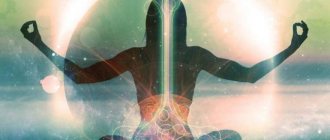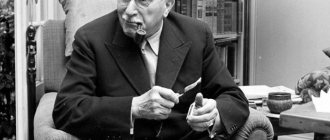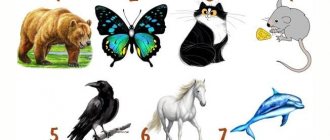Personal self-awareness is a person’s ability that helps to become aware of one’s own “I”, as well as one’s interests, needs, values, one’s behavior and experiences. All these elements interact with each other functionally and genetically, but do not evolve simultaneously. This skill arises at birth and is modified throughout human development. In modern psychology, there are three points of view on the origin of self-awareness, but one is traditional among all directions. This is an understanding of self-consciousness as the genetically original form of human consciousness.
What is self-awareness
What does self-awareness mean? This can be literally translated as “knowing oneself” or “knowing oneself.” The term comes from philosophy. It is no longer possible to say exactly who introduced this concept, but in psychology it is associated with the name of L.S. Vygotsky. This is what the author calls knowledge about himself: “a person’s awareness of himself as an individual, the focus of a person’s consciousness on himself: on his own body, needs, feelings, behavior.”
Let’s explain the concept of self-awareness in simple words, give a definition from psychology, and outline the main characteristics. In psychology, a person’s knowledge of himself is the subject’s awareness of himself as a separate unit, personality, participant in society and understanding of his place in the world.
What parts does a person's knowledge of himself consist of? From a person’s awareness and assessment of his thoughts, behavior, desires. It is connected with many other “itself”:
- self-esteem;
- self-esteem;
- self-worth;
- self-help;
- introspection;
- self-realization, etc.
Self-knowledge is based on a person’s acceptance of himself and awareness of his uniqueness. The search for purpose and self-determination in life, the individual’s beliefs and values, and worldview depend on this, in turn. Knowledge about oneself helps a person assess the prospects for further development in life.
Definitions of self-awareness from other sciences are practically the same:
- In social science, the definition is: “this is a person’s awareness of his actions, feelings, thoughts, motives of behavior, interests, and his position in society. And also this awareness of oneself as an individual capable of making decisions and being responsible for them.”
- In philosophy, the definition is formulated as follows: “this is a person’s awareness, assessment of his knowledge, moral character and interests, ideals and motives of behavior, a holistic assessment of himself as a feeling and thinking being, as the author of activity. This is the self-consciousness of the soul.
Let's look at the features of knowing about ourselves. A person’s perception of himself influences how the subject’s relationship with society develops. But at the same time, society influences the formation of an individual’s self-awareness.
So, how does the social conditioning of self-awareness manifest itself? Let's look at it with an example. Until the age of 6-7 years, a child has not yet developed critical thinking, so instead of self-esteem, he is guided by the assessment of adults. From their words, the child determines what he is like. If parents convince him that he is bad and unworthy, then the child grows up with such an attitude. In the future, when building relationships with society, he adheres to precisely this belief, and therefore he comes across bad people, manipulators, tyrants.
An example of self-awareness from life: a person understands that he lacks perseverance and motivation to move up the career ladder. He begins to analyze why he lacks motivation and compares his actions with the behavior patterns of successful people. As a result, he draws up a plan to develop the necessary qualities in himself and soon achieves success.
Interesting! Sometimes self-knowledge is called a person’s ability to separate and distinguish himself from everything that surrounds him.
Self-awareness and self-esteem of the individual
The stimulus for personal development is self-esteem. It is an emotionally charged assessment of the image of “I”, which consists of the subject’s concepts about his activities, actions, his own strengths and weaknesses. In the process of socialization of a person, the ability to self-esteem is formed. This happens gradually, as a personal attitude to actions is revealed, based on the assessments of others and the assimilation of moral principles developed by society.
Self-esteem is divided into adequate, underestimated and overestimated. People with different types of self-esteem in the same situations can behave completely differently. They will influence the development of events in every possible way, taking radically opposite actions.
Inflated self-esteem occurs in people with an idealized idea of their importance to others and the importance of personality and value. Such a person is filled with pride and pride, and therefore never admits his own knowledge gaps, mistakes or unacceptable behavior. He is lazy and often becomes aggressive and tough.
Very low self-esteem is characterized by shyness, lack of self-confidence, shyness and failure to realize one’s talents and skills. Such people are usually overly critical of themselves and set goals lower than those they could achieve. They exaggerate personal failures and cannot do without the support of others.
Active, energetic and optimistic people develop adequate self-esteem. She is distinguished by a reasonable perception of her own abilities and capabilities, a rational attitude towards failures about the appropriate level of aspirations.
For self-esteem, self-esteem also plays an important role, that is, a personal opinion about oneself, regardless of the opinions of other people, and the level of a person’s competence in a strong area.
Levels
Knowledge about oneself presupposes the formation in a person of a self-concept - a stable system of ideas about oneself. It is a product of self-awareness. In the self-concept, three levels can be distinguished, they are also called levels of self-awareness:
- cognitive – a person’s ideas about himself as a person, individuality, knowledge and acceptance of all his characteristics;
- evaluative – a sense of self-worth, self-worth, including a person’s awareness of the significance and value of his profession, external features, character;
- behavioral – behavioral attitudes and a person’s attitude towards his own personality.
These elements can be considered the structure of self-awareness. However, in psychology it is customary to consider a different system as a structure.
Individual self-awareness and social behavior
Perhaps the main categories of philosophy are matter and consciousness
.
The first split between philosophers - this happened back in Ancient Greece - was connected precisely with them. There were 2 main directions: materialism and idealism
. Philosophers classified themselves as one or the other, depending on how they answered the main question of their science. What comes first: matter or consciousness?
Matter
- objective reality given to us in sensations. Objective means that it exists independently of our knowledge about it and our attitude towards it. You can see it, hear it, touch it, smell it, taste it. Directly with your own senses or by enhancing them with devices.
Consciousness
- a subjective image of the objective world.
That is, matter
is the same for everyone, but
everyone has their own consciousness We imagine the world around us differently, essentially the same objects and phenomena. And this poses a serious problem. Okay, materialists and idealists argue. At least they almost never get into fights with each other, limiting themselves to organized discussions. Discrepancies in worldviews can lead to much more serious consequences. And then, we can never be completely sure that we reflect matter absolutely correctly, or better yet, adequately. That is, as she really is. For example, we know, of course, that the Earth revolves around the Sun.
But if you weren't told this by credible sources, what would you think? Just looking at sunrises and sunsets?
But if everything is so complicated with the reflection of objective reality in our consciousness, then what can we say about reflecting ourselves. And this is self-awareness. Awareness
a subject of himself in contrast to other subjects and the world in general.
Awareness of your interaction with the outside world. Awareness of your vital needs, thoughts, feelings, motives, instincts, experiences, actions. Self-awareness
is a subjective image of oneself.
A person is not born with ready-made knowledge about anything. Including about myself. He gets to know himself throughout almost his entire life. Often this process is never completely completed.
I know how flies land on honey,
I know death that prowls, destroying everything,
I know books, truths and rumors,
I know everything, but not myself.
, Francois Villon, summed up the process of self-knowledge
in "The Ballad of Omens".
Psychologists believe that the separation of oneself from the outside world begins at the age of 5-8 months. The child begins to distinguish his organs - arms, legs - and the body as a whole from other objects. The main source of knowledge about everything in the world, including ourselves, are adults. They give the child a name, teach him to respond to it, pronounce the names of different things and events.
The discovery of oneself as a separate “I” begins after the first year of life. But for some time the child continues to call himself not by the first person personal pronoun, but by his name. Because parents and other close people do this.
At the age of 2-3 years, a boy or girl says “I myself!” for the first time. or “I myself!” This is a very important moment in the process of self-discovery. The child realized himself as an actor, capable of performing independent actions. Regardless of those around you.
Around the age of seven, the ability to evaluate oneself is formed. That is, look at yourself from the outside. Compare your actions, abilities, appearance with what others have. A major role in the formation of self-esteem
play those statements that the child hears addressed to him by adults. The older he gets, the more important the opinions of his peers are.
Self-esteem
can be either adequate (that is, corresponds to real possibilities) or
inadequate
: overestimated or underestimated. Both are not very good. An exaggerated idea of one’s abilities and capabilities is the basis for the formation of arrogance, a disdainful attitude towards others, and selfishness. Facing failures in activity can lead to a serious psychological crisis. A person may lose self-confidence. Or become embittered, blaming others for all your problems.
If the individual
underestimates himself, this can lead to a low level of aspirations, which will interfere with self-realization. In addition, low self-esteem often provokes deviant (that is, deviant) behavior. But more on that later.
American psychologist and psychiatrist Eric Burn
This is how he explained the influence of self-esteem on attitudes towards life and others. All people, he wrote, are divided into princes and frogs. Princes perceive and accept themselves as they are. Problems and failures do not diminish them in their own eyes. They look for their reasons and try not to repeat their mistakes again. Likewise, the superiority of others in anything is not a reason for envy. Princes are happy people. And they are able to bring happiness to others.
For frogs, something or someone always interferes with their lives. They always find something to envy and something to be disappointed in. Frogs are very dependent on the opinions of other people and are always concerned about what they will think of them. They do not trust others and always expect some kind of trick from them. They associate success in life not with the actions and dignity of people, but with luck and chance. Therefore, they do not see the need to analyze the reasons for their failures. And again and again they step on the same rake.
Did you recognize yourself in the frog? Dont be upset! We are all born frogs: weak, dependent on others. It's never too late to start turning into a prince. The main thing is to realize what we are and what we want to become. By the way, frogs are divided into gray, green and brown. But if you want, read about this for yourself.
So far we have talked about external influences on self-esteem. But man
- an active being.
He is able to change the world around him and himself. There is a formula for self-esteem proposed by the American philosopher and psychologist William James
.
He believed that it could be represented as a fraction, the numerator of which is success, and the denominator is the aspirations of the individual. Surely, you know enough mathematics to figure out what paths emerge for increasing self-esteem. You can increase your success, that is, achieve a number of your goals. You can lower your aspirations by admitting to yourself that you simply cannot do something, and there is nothing wrong with that. James
himself considered the second path more preferable. He argued that the desire to constantly improve the success of our actions is too burdensome for our ego. What do you think about this?
Any work on yourself is based on knowing yourself. The process of self-discovery
- it’s a complicated thing. A person simultaneously acts as both a subject and an object of knowledge. What if the subject doesn’t like knowing some things about the object? What if we are forced to admit to ourselves that some of our actions were not caused by noble motives? That we don't have the abilities we thought we had? Or are they not as developed as we had hoped? Others can clearly see this. Do we want to admit it?
Many people cannot change something in themselves because they are not used to reflecting
. Analysis of your own feelings, thoughts and actions. We receive information about our abilities and personality traits in the process of activity and communication. But without analysis of this information, reflection, we will not be able to use it.
By observing ourselves and others, analyzing, comparing, confessing to ourselves, we will understand one very interesting thing. There is no single, permanent image of the Self. This image consists of many elements, sometimes contradicting each other. Russian Soviet poet Nikolai Zabolotsky
wrote:
How the world is changing! And how I myself am changing!
I am called by only one name,
In fact, what they call me is
I'm not alone. There are a lot of us. I'm alive.
Perhaps he knew nothing about the “self-concept” proposed by psychologists Abraham Maslow and Karl Rogers
. But he conveyed the essence of the idea quite accurately.
“I-image” is an individual’s system of ideas about himself, a conscious part of his personality. The result of reflection.
“I-real” is what I think I am.
“Ideal self” is what I would like to be and strive for this.
“Fantastic self” is what I would like to become if everything were possible.
“I-expected self” is how I think others want me to be.
“I-present” is how I would like to appear in the eyes of other people.
And many other “I”s.
Our self-esteem
, ideas about ourselves, about what we should be, how we should act in certain situations, determine our social behavior.
Behavior
- this is the totality of a person’s actions that he performs over a certain period of time, quite long. Both in standard, repeating circumstances and in changing conditions.
Let us remember that the action
- a personally significant action of a person. It represents the unity of motives, intentions, goals, means and consequences.
Social behavior is designed to elicit a certain response from individuals or society as a whole. Social actions are performed with the goal of influencing others.
There are many varieties of social behavior. Firstly, we can distinguish between adequate and inadequate
. Adequately meets the requirements of the situation and the expectations of others. What types of social behavior can be considered adequate?
Responsible Behavior
. When a person takes on certain obligations and fulfills them properly. A responsible approach to business includes the following elements:
§ understood the task at hand;
§ set a specific goal;
§ developed an action plan (and provided for possible changes);
§ selected the necessary means - resources necessary to achieve the goal;
§ and did.
Correct
refers to behavior that conforms to accepted norms and contributes to the achievement of a desired goal.
Helping
behavior - actions for the benefit of other people for which praise or reward is not expected. Share, give, help, encourage.
Syntonic
behavior. This term is most likely new to you. It is of Latin origin. “Synthonic” can be translated as “consonant.” This behavior is contrasted with conflict behavior. This is respect for the interests and needs of communication and activity partners. Attentiveness, tactfulness. Syntonic behavior prevents interpersonal conflicts. And helps resolve business conflicts in a civilized manner.
Adequate
can also be considered conformal behavior. A person's susceptibility to influence from others. When, under real or imagined pressure from a group or society, he changes his behavior or opinion about something.
Many people tend to conform
. This is one of the consequences of the social essence of man. We understand that we can only exist as part of society. And, naturally, we want to adapt to it. Since conformal behavior corresponds to the expectations of others, we classify it as a type of adequate behavior. But the desire to maintain agreement with the majority at all costs, to “keep a low profile,” can lead away from the goals that a person strives to achieve.
Let's move on to characterizing the types of inappropriate behavior
.
This is wrong behavior
, as the opposite of correct.
And the conflict
is a counterbalance to the syntonic.
Have you heard of victimization behavior
?
An infrequently encountered term. In English, victim
is a victim. We are talking about human actions that provoke an attack. He doesn’t want trouble for himself, but he acts thoughtlessly and simply attracts it to himself. If you have a habit of taking out a wad of money on the street and counting it, your chances of being robbed significantly increase. This behavior of the victim, of course, does not justify the criminal. But it is extremely frivolous on her part.
Demonstrative behavior
based on the desire to attract the attention of others, regardless of their desires and needs. Sometimes demonstrative behavior is a rational way to solve a problem. For example, women's tears in many men, who subconsciously feel themselves protectors of the weaker, cause an irresistible desire to do something, to give in. If only they would stop. Charismatic politicians can behave demonstratively. This helps to captivate its followers and gain popularity. One of the commandments of a public person: Let them speak badly of me rather than not remember me at all. But most often, demonstrative behavior is an indicator of the presence of serious psychological problems.
Deviant
(from English
deviation
- deviation) refers to behavior that does not correspond to officially established standards. Or established moral patterns and traditions. Not all deviant behavior leads to harmful consequences and is condemned by society. Non-standard actions can contribute to a more effective solution to a problem. Deviant behavior usually includes those actions that are subject to correction, punishment or treatment. You will talk about this in more detail when studying the section “Social Relations”.
Delinquent
behavior
is a type of deviant behavior.
D elictum
in Latin is a misdemeanor. These are illegal actions that violate legal norms. Crimes pose the greatest danger to society.
The structure of self-awareness
What is included in the structure of self-awareness? The structure of a person’s self-awareness includes the following elements:
- Cognitive component or self-understanding. This is a person’s knowledge of himself and the development of self-images. Usually there are four: the real self (what a person is), the ideal self (what he would like and could be), the fantastic self (what he dreams of being if he had no limitations) and the mirror self (how a person is seen those around him in his opinion).
- Emotional-evaluative component or self-attitude. Acceptance or non-acceptance of oneself, confidence or uncertainty, a sense of self-worth or devaluation of oneself - all this and the like are included in this element. In general, this is a person’s emotional and evaluative attitude towards himself: self-esteem, self-respect, self-acceptance. It is formed on the basis of social norms, stereotypes, and standards. And also based on a person’s comparison of himself with other people.
- Behavioral component or self-regulation. This is the desire to fit into society, to be accepted and understood, to meet its norms, to become a respected person and a valuable unit.
- Self-actualization. This component ensures the realization and self-development of a person. Signs of healthy self-actualization of the individual: life “here and now”, doing what you love, continuous self-development, openness to new things, honesty with yourself and others, a responsible and conscious attitude towards life, self-confidence.
- Level of aspiration. This is the desire to conquer goals that are a little further than the zone of current development, that is, a little more complicated than what a person has already conquered.
According to other sources, the main components of self-awareness look like this:
- Self-knowledge (intellectual aspect). Formed through self-observation and self-assessment.
- Self-control (self-regulation). Driven by self-esteem. The more stable and adequate the self-esteem, the higher the level of self-control.
- Self improvement. Working with self-images.
The formation of a substructure is associated with the level of development of self-awareness. Let's analyze the structure through the diagram:
Note! Self-knowledge is one of the stages in the development of consciousness. And consciousness is a person’s ability to subjectively experience and interpret events in the external and internal world.
The structure of the self-concept
At the same time, if we consider the product of self-consciousness - images of the Self, we can distinguish:
- I am real (as I am now);
- I am ideal (what I can become in accordance with my capabilities);
- I am fantastic (what I could become if it were possible).
The contradiction between the ideal self and the real self can serve as both an impetus for self-development and cause personality disharmony. It is worth noting that self-awareness is a dynamic structure. She is prone to changes and transformations of self-images.
In some theories there is a broader classification of self-images. Stands out:
- I am real;
- I am the ideal;
- Self-potential;
- I am personal;
- I-activity (professional, non-professional).
In other works, for example, Sh. Samuel, you can find the concept:
- I-bodily;
- I-real (present, actual);
- Self-dynamic;
- I-fantastic;
- I-probable;
- I-idealized;
- I-represented;
- I-ideal;
- Future (possible) self.
I am corporeal
Each person has a sense of his own body, which may differ from what is shown in the mirror. This refers to signals sent to the brain about the location of body parts, their shape and length. Within the framework of the I-bodily, we can additionally distinguish:
- real perception in terms of subjective functionality;
- internal factors caused by personal experiences or difficult situations;
- social factors, that is, environmental reactions and the interpretation of these reactions by the individual;
- the ideal body image as a result of the combination of all factors, comparison and a person’s perception of his body.
Real Me
The totality of a person’s ideas about himself at a given moment in time (as he seems to himself). However, this idea does not necessarily correspond to objective reality. The present self provides flexibility in reactions in response to changing environmental conditions. It allows you to choose personal goals, behavioral strategies, claims, and more.
Self-dynamic
Reflects the personality’s ideas about it, but in projection, that is, about what a person wants to become (goal). Depends on a person’s social status, opportunities and successes. The dynamic self is prone to changes, which are influenced by the successes and failures of the individual, identification with significant and ideal (in the person’s mind) people, ideas about desired roles and status.
I'm fantastic
Essentially, these are a person’s dreams, ideas about what he would be like if everything were possible. As a rule, this component exists only until adolescence, and as a person grows older, it begins to actively collapse.
I'm perfect
A person’s ideas about what he should become, based on the learned norms and values of society. Depends on the moral development of the individual, moral maturity and socialization. It is formed in the process of a person’s identification with people (heroes) whom he admires.
If the ideal self does not transform into the dynamic, and then into the present, then, most likely, it will disintegrate completely. This is dangerous with disappointment and frustration.
I am possible (future)
A person's ideas about what he can become. Most often it differs from the ideal self. It is formed on the basis of a person’s real position, real status, opportunities and role.
Idealized self
A person’s ideas about what he would like to be right now, how he would like to see himself. This is an incoming component that depends on the specific situation.
Self-represented
Images created and exhibited by a person specifically for display in order to hide undesirable (negative in his opinion) traits, qualities of the present self. The represented self plays the role of protection and adaptation.
Most often, the imagined Self is close to the ideal Self, but if these components differ and do not come close, then problems arise in a person’s relationships, and later the person is subject to disappointment and frustration. A sign of such inconsistency and incipient frustration is embarrassment.
I'm fake
It represents a distorted “I-real”, that is, self-deception of the individual. With frequent reproduction of false but desirable personality traits:
- afraid of negative self-esteem;
- expects negative attitude from outside;
- incapable of actions that nurture self-respect.
From the false self, many protective mechanisms of the personality are activated, which ultimately acquire a pathological character. All self-knowledge is distorted, and then the knowledge and perception of interpersonal relationships.
Functions of self-awareness
What functions and roles does a person’s knowledge about himself perform? In psychology, it is customary to distinguish the following functions of self-awareness:
- Function of development and self-improvement. The need for self-realization pushes the individual onto the path of positive changes, the transformation of the ideal self into the real self.
- Existential function. Self-awareness helps a person find meaning and purpose in life.
- Regulatory function. On the basis of his self-awareness, a person builds relationships with society, regulates and organizes his behavior and activities.
- Integrative function. A person seeks a balance between personal and social, internal and external world.
- Protective function. Despite the desire for positive changes, a person at the same time struggles to maintain his usual self-image. In life, this looks, for example, like defending personal boundaries.
The functions of self-awareness manifest themselves both individually and together.
What role does the system of knowledge about oneself play in a person’s life, the formation of his personality? Home. The better a person understands and knows himself, the more effectively he builds his life. Knowing about yourself makes it possible to work on yourself, develop, and improve yourself.
Forms of self-awareness
In an effort to better understand what self-awareness is, researchers have discovered that it comes in four different forms. Let's look at each of them in more detail.
Self-knowledge
This concept includes knowledge of one’s personal qualities, as well as physical capabilities. It provides us with self-identification among other people. Self-knowledge includes processes such as:
- monitoring the consequences of one’s own actions, actions, decisions and statements;
- observing the reactions of others to the above;
- understanding how others evaluate us, how they perceive us and how they treat us;
- analysis of one’s own feelings, desires, needs, emotions and their reasons.
The main goal of the process of self-knowledge is to form in a person a fairly complete picture of himself, an understanding of what he is and what capabilities he has.
Self-control
By receiving information about his essence, his desires and needs, a person can correct his behavior, choosing more correct, moral or rational actions. We have the power to change almost our entire reality by completely abandoning unwanted thoughts, statements or actions that contradict our current attitudes.
Self-esteem
Self-esteem serves as an indicator of how a person perceives his own qualities and capabilities, how much he loves and respects himself. A fairly self-confident person, capable of making decisions and acting purposefully, has adequate self-esteem. If self-esteem is low, then a person has to constantly depend on the opinions of others, live with a lot of complexes and feelings of guilt. Inflated self-esteem makes him arrogant, forcing him to ignore other people's opinions and worsening his interaction with others.
Self-acceptance
This form of self-awareness includes two aspects:
- accepting oneself as an individual;
- self-respect.
This implies that a person, regardless of his own qualities, capabilities, abilities, talents and knowledge, accepts himself as a full-fledged person. He does not criticize himself, does not reproach himself for shortcomings and mistakes. He is sure that he deserves everything he wants. To do this, he works on himself, develops, improves, increases the level of his education, and strives to master new skills.
Forms
Personal knowledge about oneself is a person’s system of ideas about himself, his mental and physical states. There are several forms of self-awareness.
According to the typology of V.V. Mironov forms of self-awareness are:
- Well-being. This is a person’s awareness of his body and its place, participation in the world.
- Self-identification. A person's identification with a social or cultural group.
- Personal knowledge about yourself. A person recognizes himself as someone similar to other people, but at the same time different from them. Along with this comes awareness of freedom of action and responsibility for them. Against this background, self-control and self-esteem come into play.
Sometimes these forms are called levels of human self-awareness. The first form is the lowest level, the third is the highest.
In addition to forms, it is customary in psychology to distinguish types or types of self-awareness:
- Public or social. This is a complex of collective beliefs and ideas about society during a certain period of time.
- Private. This is a person's awareness of certain aspects of himself. For example, when a subject looks in a mirror and sees his own face.
- Moral. This is a system of moral images and ideals to which a person strives.
All types are closely related to each other.
Forms and levels of human self-awareness
Self-awareness manifests itself in four forms, let's look at each of them.
Self-knowledge
This concept means identifying oneself among other people and the world around us, recognizing personal qualities, the physical body, and potential.
Self-awareness comes through:
- Self-observation of the results of one’s activities, the results of communication with the environment and analysis of the compliance of the results with accepted standards.
- Understanding the assessments of other people about their personality and actions, their attitudes.
- Analysis of your feelings, emotions and needs, and their transformations.
The result of self-knowledge is the formation of a system of ideas about oneself.
Self-control
A person has the opportunity, after analyzing his essence and behavior, to correct them. Any actions and psychological states can be changed if, in the opinion of the person himself, they contradict his attitudes, do not give the desired results, or come into conflict with the outside world.
Self-esteem
Self-esteem expresses the degree to which a person accepts his qualities, characteristics and characteristics. The perception itself reveals the level of love and respect for oneself.
Adequate self-esteem characterizes a self-confident person, capable of making decisions and purposeful actions. When low, we see a person dependent on the opinions of others, with a pronounced sense of guilt and a lot of complexes. An overestimation of personal qualities reveals a person who is self-confident, arrogant, and does not accept any criticism.
To achieve life goals, self-esteem should be developed to a normal level; in psychology there are many exercises to increase the degree of self-love.
Self-acceptance
This form of self-awareness involves:
- Accepting yourself as a unique individual, without unjustified criticism and self-deprecation.
- Self-respect.
Self-esteem comes from achieving goals and satisfying aspirations. A person sets records in sports, quits smoking, finishes writing a novel - his self-esteem increases, which has a good effect on self-esteem.
In addition to forms, psychology considers 4 levels of self-perception:
- Sensual
. This is the lowest level at which one’s psychological characteristics, experiences, and physiological processes are understood. This is the stage of self-identification. - Figurative and personal
. Gives recognition of oneself as a subject of active activity. Self-actualization occurs, maintaining the identity of “I”. - Analytical (otherwise reflexive)
. A person analyzes and clarifies his thoughts and actions, observes the manifestation of emotions in critical states, analyzes committed mistakes and failures, and draws conclusions. - Active
. Based on the results and experience of the first three stages, self-regulation, motivation, correction of behavioral structures and self-control occur. This is a stage of personal change based on self-knowledge.
Going through all four levels of self-awareness indicates the maturity of the individual; getting stuck on one of them requires further development.
How self-awareness is formed
The problem of self-awareness is complex. In psychology, it is considered from different angles. For example, they study the development of knowledge about oneself in accordance with age-related changes in a person.
How self-awareness is formed as a person grows up (stages of development of knowledge about oneself):
- From 0 to 1 year. A rudimentary knowledge of oneself arises. The child understands that he exists. The first level of development of self-awareness is characterized by awareness of biological needs: food, water, care.
- From 2 to 3 years. Allopsychic knowledge about oneself. The child begins to see himself as an independent person, to separate his actions from the actions of other people.
- From 4 to 7 years. Self-psychic knowledge about oneself is formed, that is, the child can already evaluate, understand and recognize his physical states, emotions, and feelings.
- From 8 to 17 years. The formation of self-awareness ends. The young man develops a stable system of ideas about himself.
In the future, knowledge about oneself is not formed, but modified. Thus, a person’s self-awareness mainly develops by the age of 17.
What influences the formation of self-awareness? The formation of knowledge about oneself is influenced by the significant environment, society as a whole, the assessment of the subject by other people, status in the peer group, a person’s assessment of himself, the ratio of the images of the real self and the ideal self.
Here are the prerequisites for the formation of self-awareness:
- a person’s awareness of his similarity with other people;
- consciousness of one's Self as an active principle;
- a person’s consciousness of his mental properties and qualities;
- formation of a system of social and moral attitudes.
L.S. Vygotsky believed that the development of the structure of self-consciousness occurs according to a pattern close to the development of higher mental functions.
Self-awareness and personality development
Personal self-awareness is not a quality inherent in a person at birth. It goes through a long period of evolution and improvement. However, the first beginnings of identity are observed in infancy. In general, the development of a person’s self-awareness goes through several successive stages, which can be symbolically divided into the following:
Stage 1 (up to one year) - the child separates himself from the world of people and objects. At first, he does not distinguish himself from those around him, does not distinguish his own movements from those carried out by his relatives when caring for him. Games - first with arms and legs, and then with objects of the external world, which indicate the child’s primary distinction between active and passive own roles in motor activity. This experience gives the child the opportunity to realize his own potential. The emergence and development of children's speech is of particular importance. This actually brings him into the sphere of relationships with people around him.
Stage 2 (1-3 years) – marked by intense and significant mental development. Self-awareness of a child’s personality is associated with impulses to perform actions and coordinate them over time. Contrasting yourself with others is often negative. It is from this, despite the imperfection and instability of these first forms of motivation, that the distinction of the child’s spiritual “I” begins.
Stage 3 (3-7 years) – development is smooth and even. In the third year of life, the child stops talking about himself in the third person, wants to experience his own independence and contrast himself with others. These attempts to gain independence by the individual lead to a number of conflicts with others.
Stage 4 (7-12 years) - reserves continue to accumulate, and the process of self-awareness occurs without noticeable crises and leaps. There are striking and significant changes in consciousness, associated primarily with changes in social conditions (school).
Stage 5 (12-14 years) - the child again begins to be interested in his own personality. A new crisis develops when the child seeks to be different and oppose himself to adults. Social self-awareness is clearly expressed.
Stage 6 (14-18 years) - is of particular significance, since it is here that the personality rises to a new level and itself immeasurably influences the further development of self-awareness. Finding yourself, collecting knowledge about your own identity is a paramount task. This marks the beginning of maturity.
Developing Self Awareness
The development of human self-awareness begins at birth and continues throughout life. Let us briefly present the plan for the development of self-awareness:
- the child’s awareness of the very fact of his existence (at the physical level through sensations, awareness of himself in his physical body);
- the child’s separation of himself from the surrounding world and society;
- the child’s awareness of his emotions, feelings and desires;
- development of self-esteem (evaluation of actions, behavior, personal qualities);
- the ability to determine mental states, recognize feelings and motives;
- awareness of advantages and disadvantages and other individual characteristics, development of images of the real Self and the ideal Self;
- the formation of a sense of self-worth that does not depend on external circumstances.
In the classification of Russian psychologist and philosopher S.L. Rubinstein identified the following stages in the development of human self-awareness:
- interest in the body and mastery of it;
- mastering voluntary movements;
- self-care training;
- perception of one’s Self through the prism of the past, present and future;
- formation of self-awareness, its acceptance by a person.
Knowledge about oneself is formed through self-knowledge and introspection. People also learn about themselves through communication with other people. Moreover, this is the first factor influencing the formation of self-awareness. Until the age of three, children do not recognize themselves as a separate, unique person. And only from the age of three a person begins to defend his uniqueness, to seek a balance between it and similarity with other people. The peak of searches occurs during adolescence.
Signs of developed self-awareness:
- awareness of oneself as an active being or a sense of activity;
- every minute feeling of internal unity, integrity;
- awareness of identity;
- awareness of uniqueness.
These same criteria help assess the development of a person’s knowledge about himself.
Mistakes in the development of self-awareness
The process of forming self-awareness can be defined as an identity crisis - a person’s search for his purpose, place and role in society. If the crisis is resolved unfavorably, that is, a person does not develop a healthy self-concept, self-esteem and other elements of self-awareness, then the following deviations arise:
- a person avoids close relationships, isolates himself from society, withdraws into himself;
- a person refuses to grow up, is afraid of any changes;
- a person perceives time inadequately (chronoception is distorted);
- a person cannot make a decision in life, wastes his strength and potential on many unimportant matters and dubious activities;
- a person does not accept himself, chooses negative role models.
In addition, mistakes in the process of forming knowledge about oneself lead to dependence on other people’s opinions, a distorted perception of a person’s appearance or inner world. In particularly advanced cases, mental disorders develop.
Personal self-awareness in psychology
The concept of self-awareness is so complex and multifaceted that in psychology there is still no single concept of its understanding. Synonyms for the word are: “I am a self,” “I am a concept,” “self-identity.”
The basics of the concept were formulated by S.L. Rubinstein, who pointed out the possibility of self-awareness to understand oneself, the personal environment and the existing structure of relationships with people.
According to S.V. Vygotsky, self-consciousness is formed in a person by the end of adolescence. He connects this process with the ability to reflect (think, ponder), which is formed by the age of seven.
According to the theory of V.S. Merlin's understanding of himself consists of the following components:
- Distinctive features from other subjects and objects.
- Understanding your own emotions, having self-esteem.
- Awareness of oneself as a subject of activity.
Psychologists have identified the following criteria for self-awareness:
- Isolation of the individual from the environment (material and social).
- Understanding the ability to control oneself – actions and thoughts.
- Trying on the visible qualities of other people.
- The ability to see your needs and the deep motives of your actions.
- Awareness of one’s own character traits and personality traits, both existing and desired.
In addition, within the framework of self-awareness in psychology, such a factor as attitude towards other people is highlighted; it can also be different.
The egocentric layer assumes that the individual forms an attitude towards others in accordance with their attitude towards themselves. That is, if they love me, then I love, if they respect me, then I will respect.
The group-centric stage of relationships is based on the principle: “If a person belongs to a certain group, then he is correct.” It is assumed that the person himself belongs to this same group.
A prosocial approach ensures understanding of the value of any person and acceptance of him with all his shortcomings.
At the highest, estoholic level, other people are considered as part of the spiritual world, humanity and patience are positioned in relation to any individual.
Ways to know yourself
Let's move from theory to practice and find out with what methods and tools you can dive deeper into your personality, get to know yourself better and find harmony.
1. Slowdown
It is logical that with our rhythm of life it is extremely difficult to engage in self-knowledge. Start by slowing down and taking time for yourself. There are 24 hours in a day and, believe me, if you use them wisely, you can find time for anything.
I recommend reading about time management techniques that will help you manage your life more productively.
The right questions
Two main questions that are important to regularly ask yourself:
- What's going on in my life right now?
- How okay am I with this?
It is better to record the answers that pop up in your head on paper point by point. For a more comprehensive understanding, it is better to take several areas of life at once and go through each of them. Ask yourself: “What is happening now with my personal life, professional fulfillment, health, finances, creative self-expression?”
If distortions that create discomfort have been identified in some areas, you should move to the next stage and find out the reasons, possible methods of correction, or even the validity of personal claims to this or that area of life.
What other questions will help you get to know yourself better:
- How am I feeling at the moment?
- Who am I? Who do I consider myself to be, what place do I occupy in society, at work, in the family?
- What is my life goal and values, where am I going?
- Do I have any grudges against my parents and if so, what is the reason?
- What kind of people do I like and dislike?
- What actions and achievements am I proud of?
- In what situations did I act incorrectly and could this have been avoided?
- What things in life do I consider the most important? How much time do I devote to them?
- What purchases do I often make based on advertising or trends that end up not making me happy?
- What addictions are dragging me down? Am I ready to correct them?
- What negative traits of my character would I not want to demonstrate to people dear to me and those around me?
- What's making me jealous lately?
- What prevents me from making decisions and making my life better?
Even more questions that reveal your personality can be found in self-discovery tests.
Self-observation and self-analysis
Simply observing your behavior, internal sensations, emotions, reactions to certain words and events will help you get to know yourself. Such observation must certainly be followed by self-analysis, which will help confirm or refute your own conclusions, find out the reasons and think about improving the situation.
Let me give you an example. Observing himself, a person realizes that he is overly shy. Through introspection, it is possible to confirm this fact: it can be difficult to get comfortable in the company of strangers, it is difficult to express your point of view, there is a desire to remain silent, sit out, when you try to say something, your throat dries up, your face turns red.
After this, an assessment is made: whether attacks of embarrassment always occur or only in specific situations and under certain conditions. Next, the person looks for ways to cope with his shyness, performs various techniques, practices, signs up for trainings, etc.
By the way, I advise you to read our article on how to get rid of complexes.
Mindfulness
Control over one's actions, thoughts and feelings makes a person truly the master of his destiny.
The Indian philosopher Osho in his book “Mindfulness” described the practice of being in the “here and now” state. He believes that the most important skill to learn is observation. Here are the recommendations he gives:
- Watch every action you take, every thought that passes through your mind, every desire that comes over you.
- Watch what and how you say, what gestures you use, how you walk and even brush your teeth and take a bath.
- Do not eat mechanically, stuffing your mouth with food, chew with observation, with feeling. Otherwise, even the most delicious food will seem bland and will not bring satisfaction.
- Watch. This way you will understand how much you have missed so far.
Psychological work
It consists of reading books on psychology and socionics, passing psychological tests, identifying one’s own psychotype, chronotype, etc.
There are many classifications of human personality types: according to Holland, according to Jung, according to temperament, perception, etc.
Here, for example, is what the socionic division of personality types looks like (see picture below).
Application of various techniques
I will give an example of the simplest and safest technique of self-knowledge, which is based on art therapy and psychological work with subpersonalities.
The practice takes place in two stages:
- Thoughtful. Close your eyes and imagine yourself in the future. The term can be any – 1 month, 5–10 years. Pay attention to how you look, what you have, what you don’t have, whether you are happy, how you feel, what you do, who you live with, who you are close to, etc.
- Expression in a drawing. Now transfer the presented image onto paper. Don't chase technique. The main thing is to be creative, choose colors and shapes.
The point of this technique is to correlate the image that was created in the imagination with what is now in reality. This will give you the opportunity to understand what is in the future and what is missing at the moment, what you would like to get or, conversely, what to get rid of.
If the future seems vague and uncomfortable, it is worth thinking about the psychological blocks that, even at the level of imagination, do not allow you to see yourself as joyful and harmonious. In this case, the block can also be represented in the form of a drawing, thinking about what color, size, shape it might have, what it looks like, what it serves, etc.
You might be interested in reading about how to get out of depression.
Esoteric systems
Anyone who does not consider himself an inveterate skeptic can use various esoteric tools that allow him to look deeper into his inner world. These include:
- astrology;
- human design (Human Design);
- tarot cards;
- numerology;
- meditation;
- yoga;
- qigong;
- space energy;
- Reiki energy;
- channeling.
There are actually a lot of such techniques. At the same time, it is not at all necessary to rush to extremes and begin to comprehend everything at once. There may be something for everyone. For example, I have been doing yoga with a trainer for several years, I like meditation, and I am also interested in numerology, Tarot and Human Design. Perhaps you too can reveal new facets of your personality with the help of one of these tools.
I recommend taking spiritual development courses. You will get to know yourself better, unlock your potential and be able to achieve inner harmony.
Functions and purposes
Goals:
- Cognition, experience of the inner world.
- Reflection of the world.
- Study of feelings, emotions.
- Overcoming psychological barriers and fears that prevent development and block certain areas of life.
The main function of self-awareness is to evaluate oneself from the outside, to study personal motives and the results of actions. Additional tasks:
- interpretation of experience;
- setting expectations;
- ensuring internal consistency;
- identifying personal boundaries.
Self-awareness must ensure the individual's conscious adaptation in relation to the environment. After studying personal characteristics, an individual can change to achieve the ideal. If an individual is mistaken about his qualities and actions, he will face difficulties and disappointments.
How does a person’s self-awareness ultimately influence his or her development?
Self-development has become not just a psychological concept of personal growth, but also a fashionable, prestigious cultural pastime. Anyone who is engaged in their growth and desire to achieve goals spends effort and time on this. But how do people know how to improve through self-development?
First, a person must decide what exactly he has decided to modify in himself. Any vague concepts are not suitable, for example, to become spiritual, because everyone has their own concept of spirituality. You should clearly identify your new personality traits that you want to develop in yourself in order to take specific actions.
After setting a goal, start moving towards it. For example, you decided to moderate the level of aggression in yourself, then every time you feel that you are starting to “burn with rage,” try not to give in to it, not to respond to other people’s remarks and calm your emotional background. By independently developing certain qualities of your personality, you can achieve high results.
It is believed that those who do not grow die very quickly. The modern world is changing very quickly, so every six months you should change your approach to the same thing. Self-development can help you deal adequately with constant changes and withstand the eternal race for survival and mental happiness. In addition, self-control will allow you to discover your energy, new abilities and potential for many actions.
Why is it so difficult to know yourself?
There are several reasons:
- Lack of time. We live at a frantic pace, rack our brains over how to combine work and family, chase earnings, experience stress and have trouble sleeping. In this way of life, the idea of self-knowledge seems sheer nonsense. In our daily time pressure, we sometimes have no time to sit in silence and drink a cup of tea. What kind of knowledge can we talk about there? By the way, I recommend reading our article on how to deal with stress, and also familiarize yourself with a selection of books to improve the quality of your sleep.
- Focus on the external. We are more in need of external success, promotion, status, influence, material goods and underestimate the importance of satisfying our internal hunger. However, achieving success is very closely related to self-analysis. If you don't pay attention to what's inside, you can get devastated even when you reach decent heights.
- Reluctance to face the truth. We all sometimes commit unpleasant acts, utter hurtful words, and behave unworthily. If you start delving into your personality, you can find a lot of negative things there. Who likes to learn this about themselves? It’s much easier not to notice and not interfere with the comfortable perception of your loved one. Otherwise, we will have to change something and destroy the world to which we are so accustomed.
- Lack of awareness of actions. We do many things in our lives unconsciously. Since it is difficult for the brain to concentrate on all the actions in each moment, all the feelings and emotions, it takes the path of least resistance and turns on autopilot.
- Identifying yourself with your thoughts. Possessing pronounced critical thinking, a person forgets that he is a combination of mind, feelings and body. With such a limited way of exploring oneself, it is extremely difficult to achieve self-knowledge.
- Guide only by feelings. This assumes the opposite situation to the previous point, when a person follows momentary feelings, not taking into account the fact that the assessment of reality can be distorted due to various factors.










